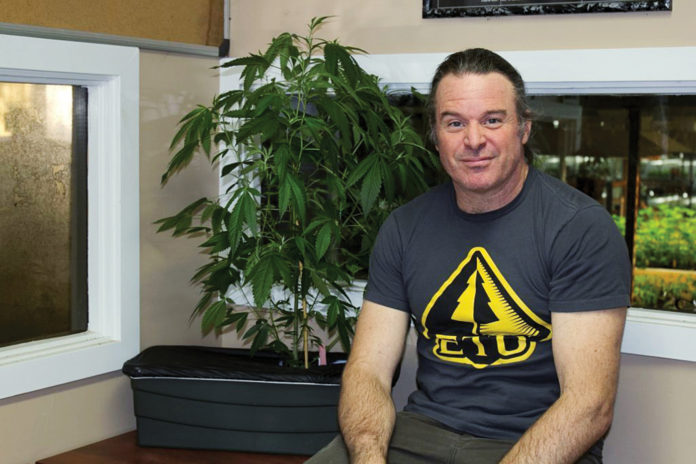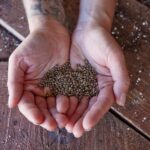Originally from Rhode Island, Kevin Jodrey spent years as a self-professed outlaw grower in California before going legal. In 2008, he joined a dispensary called the Humboldt Patient Resource Center (HPRC), where he helped isolate CBD genetics from a Spain-bred strain called Cannatonic. Since then, he’s become one of the most respected cannabis breeders in the industry.
“Around 2009, Jamie of Resin Seeds came to Humboldt [County, California] with the original Cannatonic line,” Jodrey told Leafly in January. “He provided it to Dr. William Courtney, who reached out to a grower named Dready Aaron. They brought the stock to me over at HPRC because they needed a place to legally hold it and sift it for unique [phenotypes]. At the time, I was cultivation director of the resource center and I agreed to allow them to conduct their research in the facility. Together, we started locating the outlier cultivars.”
In 2012, Jodrey purchased the Grass nursery in Garberville, California, which he renamed Wonderland Nursery. A year later, he and the team began an effort called “Free CBD for the People.”
“Financed by THC-dominant clone sales at Wonderland Nursery, between 2013 to 2017 we gave away upwards of 150,000 CBD clones,” he told Leafly. “Additionally, we provided information to patients on how to cultivate strains while allowing them to access laboratory testing for free. This allowed patients to start their own breeding projects. It was important to build seed lines, because to a lot of the patients, clones took too much energy to keep alive.”
A natural and effusive communicator, Jodrey has produced a series of educational videos about breeding—a service he does without charge, reflecting his willingness to help craft farmers find a conceivable, if unlikely, path to long-term survival.
Altitude
In Jodrey’s view, the area best-suited for cultivation is Humboldt County’s timber production zone. “Because you’re above the fog and you have beautiful airflow,” he told mg, adding good water sources and sun penetration make the area even more suitable for cannabis. “These higher-altitude spaces have a lot more wind blowing [through] them than you do in a canyon, and you’re above the fog level, so you have a lot less pathogenic pressure on the plant.
“I have a half-acre that’s permitted, and I could have gone up to a full acre if I had moved [down the mountain, as the county wanted],” he continued. “But as a cannabis cultivator, even though I think the alluvial flood plains of the Eel River are great for dry-land farming, they also limit your cycle because at the end of the season you have incredible amounts of mold and fungus pressure. To me, it limits what you can cultivate. Certain things can’t be grown in those low-lying areas. I’m right at about 2,200 feet.”
Wonderland Nursery would not work at a higher elevation, he said, because seed-grown plants and clones require very different environments. “The difference between nursery genetics and farm genetics is nursery genetics are juvenile, and they have to have flower,” he said. “It’s a lot easier to keep the plants clean and moving through the system in a nursery. As plants flower, they’re just like people. Problems that didn’t cause you much of an issue at [age] 12, at [age] 76, they become a problem. Similarly, when plants go through the flowering cycle, they’re basically dying until the end, when we take them. They start to lose resistance as they go through their life, and you have to make sure the place the plant finishes its life is optimal for that stage.”
The thought process for growers deciding what to grow is the same, said Jodrey, whose experience as a retailer taught him about market-driven forces and how to consider his own future.
“I started the nursery industry; [Wonderland is] nursery number one,” he said. “The largest companies in the state hit me up to say, ‘Bro, you’re the one that started the whole revolution of nursery operations.’ So, I understand our role as a nursery, and as a farmer I understand the role, but the store is where I got the education more than any place because the cash register tells the truth.”
Blue-collar stoner
“The truth is, the people that buy pot have always been blue-collar people; they’re not wealthy,” said Jodrey. Predictably, he thinks the successful farmer will be the smart farmer. “There isn’t a small farmer in existence who can sell their own cannabis store-by-store throughout the state,” he said. “You’re going to have to convince these people they need to buy your pot at a higher price. You’re going to have to argue this out with the cash register.
“The regions are going to have to work together,” he added. “In an ideal situation, the farmers would team up to have buying power where they are able to negotiate contracts with nurseries to get material cheaper. It’s basically the Flow Kana model: ‘You bring everything to us, and we do everything else.’ With Flow Kana, the problem is they’re also taking money off every touchpoint, so by the time you get to the end of the sale, you’re basically at break-even. How does it help you as a farmer?
“So,” he continued, “all the craft farmers are either going to have to get together in craft organizations or they’ll be under the Sunkist model, where Sunkist provides them with all the genetics and methodologies.”
What about original genetics? “Everywhere I travel, I talk to people in the same situation,” he said. “They’re trying to work with a couple of varietals they were able to hold onto and reintroduce to the public.” The problem, he noted, is “the genetic material that remains in the world today that we can work with is very small.” The situation is the result of two irritating phenomena: First, “law enforcement has done such an incredible job chewing up the genetic population [during raids],” and “people only wanting one thing. The Starbucks model chewed up the rest of them. You get the same shit no matter where you go. Well, the problem is real cannabis was never that. There was always a little differentiation” based on the interaction between genotype and growing environment.
“And it gets even worse,” he added, “because you have about twenty-seven broad utility patents right now that say, ‘If this varietal has a one-to-one ratio with no myrcene and the total numbers are below this, we own it.’ That means if it’s something that fits what you’re growing, you have someone who has a patent on your variety under a broad patent.”
Smart breeding
“Most people buy a Honda or Toyota, not a Maserati,” said Jodrey. “But to me, craft cannabis is a Maserati. That means you’re going to have to be able to get it into specific markets where people recognize that you’re producing something experiential, where they can experience the quality in a way you can’t deny.”
How will that happen? “It’s going to have to be through education, where you get the market to meet the farmers, experience their products,” he said. “Humboldt farmers are basically going to take a beating for a while until [cannabis is legalized] nationwide and globally. Once we go global, it’ll allow us to have access to a larger market where there is a desire for the product.
“This isn’t just Humboldt,” he continued. “I was just up in Vancouver talking to farmers in the Kootenay Mountains. I’m talking to farmers in eastern Washington, western Washington, Oregon, and California—girls and guys at different levels of farming. But all these craft groups have varietals that were historically developed in their region that worked well for the cultivation they did there. So, you add varietals that were chosen not just as the cultivar, which means it’s the plant that grows well, but the chemovar, which is the combination of terpenes and cannabinoids that make it attractive to the end user. These historical varieties still have a value, but it’s trying to get them back out into the world. The question is, how does a regular farmer go about advertising them?”
The answer to that, he said, is location, location, location. “What I feel about it is in these regional appellation zones, if farmers in these zones agree to work on some specific stuff in common so they can have enough really beautiful products available and then work on things that are more for the commercial market, they can survive. Then, over the course of time, [they will] be able to get into a situation where they’ll have brand identity and knowledge of the varietals,” he said. “All of us that are really caught up with high-end cannabis are the ones growing it. But what I know from running a store, and what I try to tell people all the time, is the customers who used to buy the high-end products were growers, not regular smokers.
“That’s why the live resin market just plummeted in price, because who buys it? The growers were buying it,” he added. “Mainstream wants pens and cheap distillate. They want it flavored, and they want it to [produce] good [effects]. My argument always is this: Go to the supermarket and then tell me how big the organic aisle is. It’s half an aisle in fifty aisles of floor space. If the organic market is so dominant, why is the organic section so small in every supermarket?”
Farmers markets also hold little hope, he said. “Everyone I know who sells at farmers markets is basically living a farmer’s life and not making the profit needed to comply with the regulatory scheme of modern cannabis.”
For Jodrey, the future of craft cannabis is squarely in the hands of the craft farmer. “We have to make sure we survive the short term through genomic choices that work in reality—things that are good for biomass production and things that have an unbelievable velocity because of numbers,” he said. “Only then do we start to work on our emotional plea of, ‘My pot’s better.’”











